In a recent post (titled “Third-Party DataCentres are becoming increasingly attractive rather than Enterprise DataCentres, according to a recent Uptime Institute’s Survey“) I refer to the The Uptime Institute’s “Data Center Industry Survey” (2013): http://uptimeinstitute.com/2013-survey-results. Among other points, that survey analyzes DCIM software adoption and show that is high this year, reaching a 38% among respondents, with the major driver being capacity planning; however in 2012, in spite of enormous interest in and that a fair percentage were already using tools that could be described as DCIM, there was no single concerted focus on what DCIM needed to be deployed.
Besides the adoption rate is even higher in Europe, which leads global DCIM adoption at nearly 50%. Also, large organizations and colocation companies have adopted DCIM in the 50% range.
As Uptime Institute recognizes, both industry-watchers and DCIM vendors have suggested that 38% adoption is too high. So where is the discrepancy? 2 facts could clarify the subject according to The Uptime Institute:
- Uptime Institute’s audience base tends to be larger, more advanced data center owners and operators – Uptime Institute Network members, Tier-certified data center owners, etc. – therefore, more likely to be ahead on leading-edge technology adoption.
- Also, the term DCIM has been used to include anything from a home-grown system of spreadsheets and monitors, to an advanced suite of fully integrated tools spanning multiple data centers.
Please, let me analyze the latter point. In order to solve the problem, this year Uptime Institute provided respondents with 451 Research’s definition of DCIM before the question, in order to provide clarity:
DCIM is defined as a data center-wide or organization-wide system or suite that collects and manages information about a data center’s assets, resource use and operational status.
By the way I think Gartner’s definition is quite better and clarifying:
So, The Uptime Institute asked respondents specifically to exclude spreadsheets, BIM-type drafting programs and basic BMS systems. But I think do not eliminate partial solutions without intention or possibility to afford the whole dimension of DCIM.DCIM is the integration of information technology and facility management disciplines to centralize monitoring, management and intelligent capacity planning of a data center’s critical systems. It enables a common, real-time monitoring and management platform for all interdependent systems across IT and facility infrastructures. (Note: Therefore, it enables the monitoring and collection of low-level infrastructure data to enable intelligent analysis by individuals with domain expertise (e.g., capacity planners and facilities planners), as well as holistic analysis of the overall infrastructure, and in consequence, a full DCIM solution provides detailed monitoring and measurement of data center performance, utilization and energy consumption, supporting more-efficient, cost-effective and greener environments).
Now let me introduce a new survey, carried out by IDC and this is summarized in the infographic that you can find here.
According to IDC survey 92% of DataCenter manager see DCIM as the solution to traditional DC problems:
- Inconsistent Data Information.
- Divided Data Center Operations.
- Inconsistent Data Center Maturity.
And those problems result in that 84% of data centers have had issues with power, space, cooling capacity, assets and uptime. These issues went on to negatively impact the business process:
- 31% – Delay in application rollouts
- 30% – Disrupted ability to provide service to customers
- 27% – Forced to spend unplanned OPEX budget
- 26% – Need to roll back an application deployment.
In the other hand, coming to the Uptime Institute survey and concretely to one of the points stated in the first paragraph of this post, 70% of respondents listed “improving capacity planning” as a top driver for buying DCIM. All other drivers were distant runners up. Capacity planning mistakes will be expensive, and could cripple a business. The industry is hungry for any solution that will help make this exercise less of a guessing game. Also, in second place (a 30%), is concerned with indentifying availability threats in advance:
And when asked about the features wished in DCIM the responses were:
Answers that fit perfectly with the survey done by IDC that concludes that about 70% of respondents wish the next 4 functionalities:
- Real-time monitoring, including power and temperature
- Alerts and alarms for power and cooling
- Inventory and asset management
- Capacity analysis and planning
Finally, changing the subject, concerning to barriers to adopt DCIM Over 60% of Uptime Institute respondents globally said cost was the primary barrier to DCIM adoption, and the second one (but with a 37%, i.e. far from the first one), the integration of DCIM with the existing systems:
And the fact is that while small companies are deploying inexpensive DCIM tools (48% report spending less than $100k), the largest companies are spending significantly more for scalability and features (24% report spending over $300k):
Note: in the above tables cost doesn’t reflect the investment in human resources needs (from training to specialized technicians and so on).

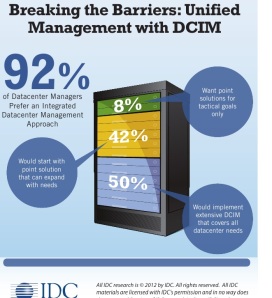
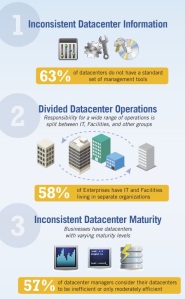
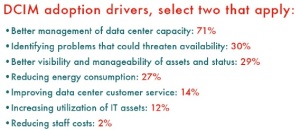
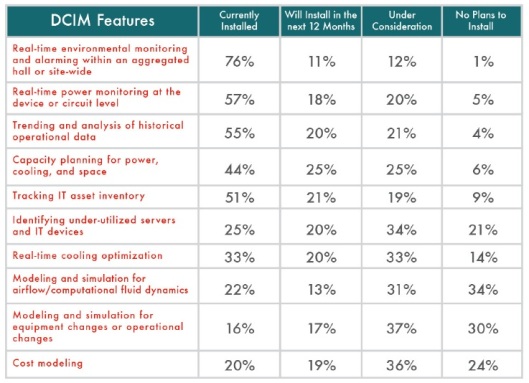
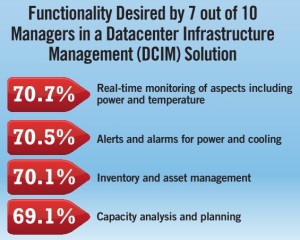
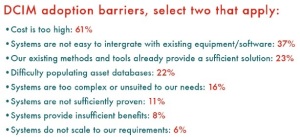

No hay comentarios:
Publicar un comentario